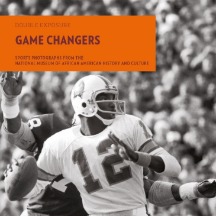The Smithsonian’s National Museum of African American History and Culture (NMAAHC) will publish a dynamic new book September 17 tracing the history of sports through photographs from the turn of the 20th century to the present day with Game Changers: Sports Photographs from the National Museum of African American History and Culture.
This publication is the first in the Double Exposure series to include photographs from the Johnson Publishing Company Archive, co-owned by the museum and the Getty Research Institute. The 84-page softcover book showcases 57 black-and-white and 11 color images.
“The Black athlete has long served as a symbol of excellence, a figure of change, and an image of the otherwise impossible,” wrote Kevin Young, Andrew W. Mellon Director of NMAAHC, in the foreword to the book. “We soar when they do, we root for them even as we doubt; we win even when they lose, as long as the attempt proves as noble as the victory. More than 20 of the photographs in this book, spanning almost 40 years, come from the Johnson Publishing Company Archive, remarkable for its ability to get inside athletes’ homes and experiences, documenting ordinary moments in often extraordinary lives.”
Organized around key moments in the history of African American sports, Game Changers explores the sometimes-complex world of athletes, their sports and their impact on American culture on and off the field. While football, basketball, baseball and boxing are prominently featured, the book also includes images of male and female athletes, amateur and professional, competing in gymnastics, track and field, skiing, golf, tennis and other sports.
Images of iconic moments in sports history include Jack Johnson vs. Jim Jeffries during the 1910 “Fight of the Century,” Jackie Robinson stealing home in 1952 and Colin Kaepernick taking a knee in 2016. Also presented are the more personal moments—Larry Doby teaching his son how to hold a bat, Wilt Chamberlain in class at the University of Kansas, Wilma Rudolph standing outside her charitable foundation office, Muhammad Ali in conversation with Fannie Lou Hamer and a young Venus Williams smiling after a practice session.
Cover of Game Changers: Sports Photographs

Among the 40 featured photographers are Ernest C. Withers, Roderick J. Lyons, Walter Iooss Jr., Maurice Sorrell, Ozier Muhammad and Moneta Sleet Jr.
Game Changers features three essays followed by four sections of photographs:
Survival and Community Building: 1900–1945
This section explores how African Americans created a vibrant yet diverse sporting culture in the face of segregation and other constraints. It also covers how the Great Migration shaped youth athletics in Chicago and the role of historically Black colleges and universities, such as Samuel Huston College and Tuskegee Institute, in promoting sports at the collegiate level.
Struggle and Breakthrough: 1945–1968
The period between the end of World War II and the Civil Rights Movement focuses on the various athletes, starting with Robinson in 1945 who integrated sports, and how some let their accomplishments speak for themselves, while others used their platforms to speak out in support of the movement. Featured athletes include Willie Mays, Althea Gibson and Wilt Chamberlain.
Disruption and Acceptance: 1968–1980
The post-Civil Rights Movement era saw an increase in athletes as activists on the national and international stage, pushing for equal pay, representation and opportunities in all levels of sports. This section features Kareem Abdul-Jabbar executing a slam dunk, Debra Kay Thomas playing in the Women’s Professional Basketball League and the first African American to play in the Master’s Tournament, Lee Elder.
Innovation and Dominance: 1980–Today
The final section looks at the progress African Americans have made since 1980, focusing on the emergence of prominent women athletes, including Gail Devers and Briana Scurry, and the participation of Black athletes, such as Kaepernick, in the social justice protests of the 2000s.
Game Changers features three essays followed by four sections of photographs:
Survival and Community Building: 1900–1945
This section explores how African Americans created a vibrant yet diverse sporting culture in the face of segregation and other constraints. It also covers how the Great Migration shaped youth athletics in Chicago and the role of historically Black colleges and universities, such as Samuel Huston College and Tuskegee Institute, in promoting sports at the collegiate level.
Struggle and Breakthrough: 1945–1968
The period between the end of World War II and the Civil Rights Movement focuses on the various athletes, starting with Robinson in 1945 who integrated sports, and how some let their accomplishments speak for themselves, while others used their platforms to speak out in support of the movement. Featured athletes include Willie Mays, Althea Gibson and Wilt Chamberlain.
Disruption and Acceptance: 1968–1980
The post-Civil Rights Movement era saw an increase in athletes as activists on the national and international stage, pushing for equal pay, representation and opportunities in all levels of sports. This section features Kareem Abdul-Jabbar executing a slam dunk, Debra Kay Thomas playing in the Women’s Professional Basketball League and the first African American to play in the Master’s Tournament, Lee Elder.
Innovation and Dominance: 1980–Today
The final section looks at the progress African Americans have made since 1980, focusing on the emergence of prominent women athletes, including Gail Devers and Briana Scurry, and the participation of Black athletes, such as Kaepernick, in the social justice protests of the 2000s.
Advertisers | Contact Us | Events | Links | Media Kit | Our Company | Payments Pier
Press Room | Print Cover Stories Archives | Electronic Issues and Talk Radio Archives | Writer's Guidelines






